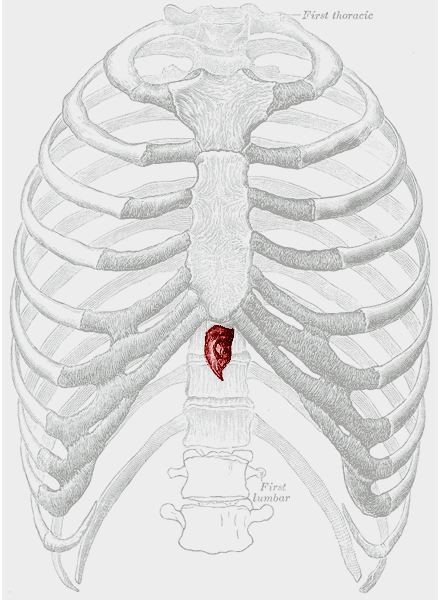What Is the Xiphoid Process and What Is Its Function?
In anatomy, a process is a projection or outgrowth from another body part. The xiphoid process is a small cartilaginous or bony projection from the lowermost portion of the sternum (breastbone). It is also called the xiphisternum or the xiphisternal bone.
Description
The first ten ribs extend from the spine, wrap around the chest, and join the sternum at the center of the chest. The xiphoid process is a small extension protruding downward from the site where the lowermost ribs join the sternum. You can feel your xiphoid process by feeling your lowermost rib and following it to your chest; the xiphoid process is just below that.
The portion of the sternum above the xiphoid process is called the manubrium. The immobile joint between the two portions of the sternum is called the xiphisternal joint. The xiphoid process is roughly teardrop-shaped, and there is a small hole in it.
At right: The location, shape, and size of the xiphoid process (click to enlarge). Modified from Grey’s Anatomy.
Development
In early life, the xiphoid process starts out mainly as cartilage. As a person ages, the process becomes more and more ossified (bony). The xiphisternal joint is usually fused to the manubrium by middle life, forming a single sternum bone. The pattern of cartilage gradually being replaced by bone is seen in many other bones of the body, such as the growth plates of limb bones.
Function
The xiphoid process anchors several important muscles, including the abdominal diaphragm, a sheet-like muscle that is necessary for normal breathing. It also anchors the rectus abdominus muscle (the “abs,” responsible for the bodybuilder’s “sixpack”) and the transversus thoracis muscle, located just inside the front of the ribs.
CPR
During cardiopulmonary resuscitation (CPR), care should be taken not to put pressure on the xiphoid process, as this unsupported structure can break off and cause damage to internal organs. Certain CPR hand positions are not safe in many women and people of short stature because the hand extends over or even past the base of the sternum (Kusonoki et al. 2009).
- Probert Encyclopedia
- InnerBody.com
- Kusunoki, S., et al. “Safety of the inter-nipple line hand position landmark for chest compression.” Resuscitation 2009 Oct;80(10):1175-80.
